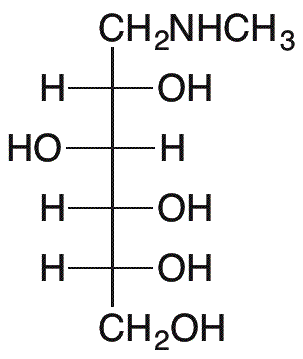N-Methyl-D-glucamine is widely utilized in research focused on:
- Pharmaceutical Formulations: This compound serves as a stabilizing agent in various drug formulations, enhancing solubility and bioavailability of active ingredients.
- Diagnostic Agents: It is commonly used in the production of contrast agents for medical imaging, improving the clarity and detail of images in procedures like MRI and CT scans.
- Biochemical Research: Researchers leverage its properties in studies involving carbohydrate metabolism and enzyme interactions, providing insights into metabolic pathways.
- Food Industry: N-Methyl-D-glucamine acts as a food additive, particularly in sweeteners, where it enhances flavor profiles without adding calories.
- Cosmetic Applications: The compound is incorporated into skincare products for its moisturizing properties, helping to improve skin hydration and texture.
General Information
Properties
Safety and Regulations
Applications
N-Methyl-D-glucamine is widely utilized in research focused on:
- Pharmaceutical Formulations: This compound serves as a stabilizing agent in various drug formulations, enhancing solubility and bioavailability of active ingredients.
- Diagnostic Agents: It is commonly used in the production of contrast agents for medical imaging, improving the clarity and detail of images in procedures like MRI and CT scans.
- Biochemical Research: Researchers leverage its properties in studies involving carbohydrate metabolism and enzyme interactions, providing insights into metabolic pathways.
- Food Industry: N-Methyl-D-glucamine acts as a food additive, particularly in sweeteners, where it enhances flavor profiles without adding calories.
- Cosmetic Applications: The compound is incorporated into skincare products for its moisturizing properties, helping to improve skin hydration and texture.
Documents
Safety Data Sheets (SDS)
The SDS provides comprehensive safety information on handling, storage, and disposal of the product.
Product Specification (PS)
The PS provides a comprehensive breakdown of the product’s properties, including chemical composition, physical state, purity, and storage requirements. It also details acceptable quality ranges and the product's intended applications.
Certificates of Analysis (COA)
Search for Certificates of Analysis (COA) by entering the products Lot Number. Lot and Batch Numbers can be found on a product’s label following the words ‘Lot’ or ‘Batch’.
*Catalog Number
*Lot Number
Certificates Of Origin (COO)
This COO confirms the country where the product was manufactured, and also details the materials and components used in it and whether it is derived from natural, synthetic, or other specific sources. This certificate may be required for customs, trade, and regulatory compliance.
*Catalog Number
*Lot Number
Safety Data Sheets (SDS)
The SDS provides comprehensive safety information on handling, storage, and disposal of the product.
DownloadProduct Specification (PS)
The PS provides a comprehensive breakdown of the product’s properties, including chemical composition, physical state, purity, and storage requirements. It also details acceptable quality ranges and the product's intended applications.
DownloadCertificates of Analysis (COA)
Search for Certificates of Analysis (COA) by entering the products Lot Number. Lot and Batch Numbers can be found on a product’s label following the words ‘Lot’ or ‘Batch’.
*Catalog Number
*Lot Number
Certificates Of Origin (COO)
This COO confirms the country where the product was manufactured, and also details the materials and components used in it and whether it is derived from natural, synthetic, or other specific sources. This certificate may be required for customs, trade, and regulatory compliance.


